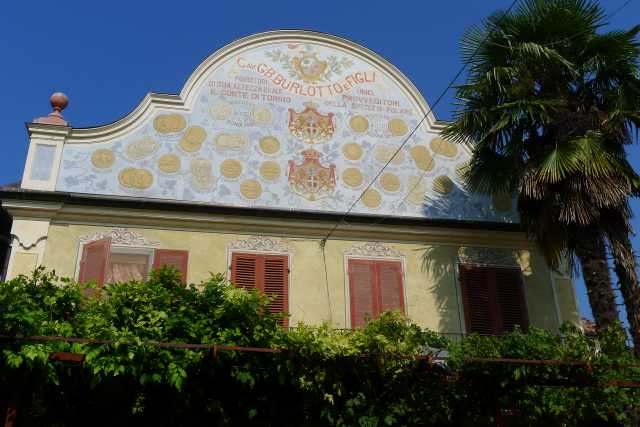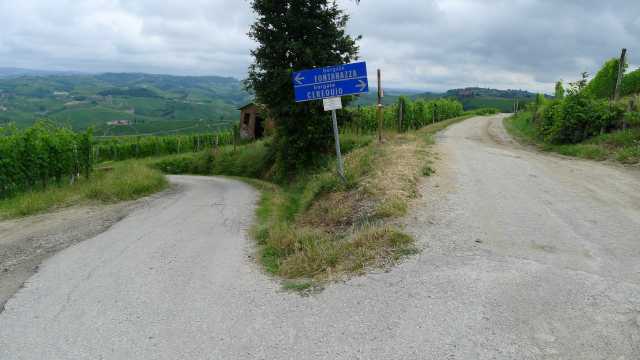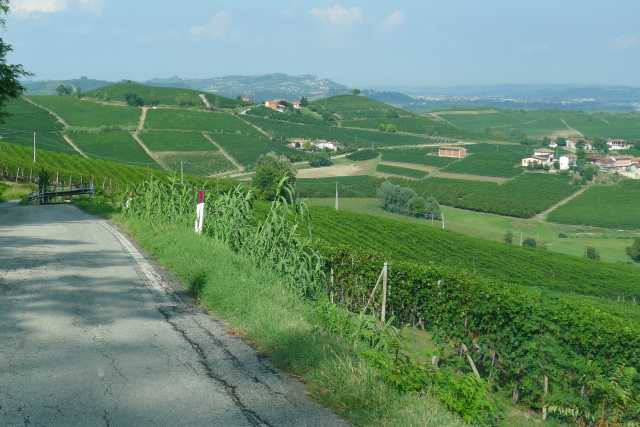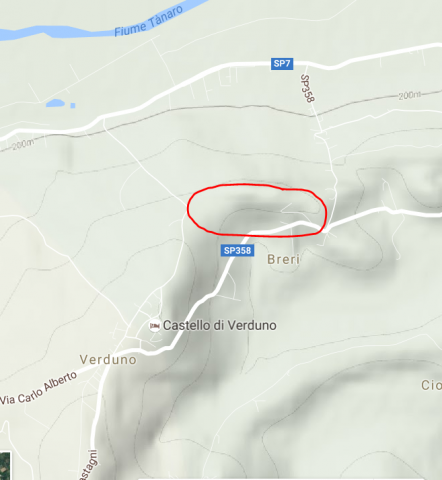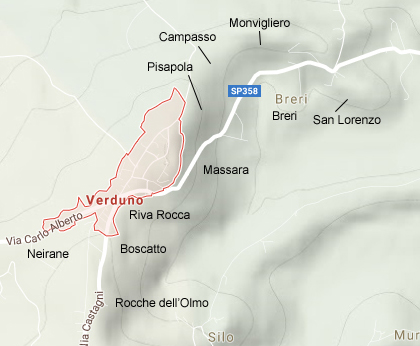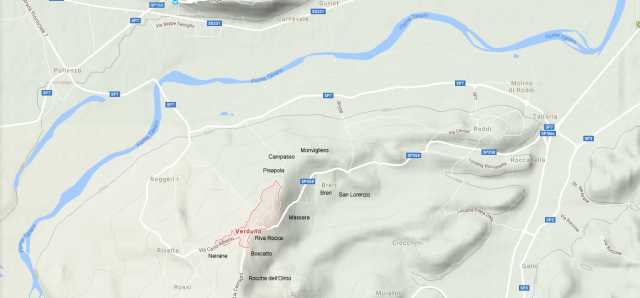Time to post my notes from Verduno, I guess.
On my last visit to the region, in 2011, I made it my mission to look close up at as many famous vineyards as I could. Maps in hand, I drove along the small road that divides Brunate and La Serra in La Morra and navigated past Giuseppe Mascarello’s monopole Monprivato and Cavallotto’s monopole Bricco Boschi in Castiglione.
(There are risks to this, as some of these vineyard roads are better suited to Land Rovers or tractors than to European subcompacts. I bottomed out repeatedly on the steep, rain-rutted dirt road to the hamlet of Cerequoi – it was more of a gully than a road – before dead-ending in the middle of some derelict farm buildings. I was worried I’d lose part of the transmission, or a wheel, on the climb back up. But what the hell – it’s a rental car, right? Epilog: Five years later, the dilapidated barns and house have been converted to a luxury agriturismo. That’s the recent history of the Langhe writ large. I assume the road is now paved so the Mercs and BMWs can make it down the hill.)
This trip I saw Ceretta and Prapo on my visit to Germano, checked out Cannubi and other key crus in the commune of Barolo and meandered up through Bussia and back along the Rocche di Castiglione ridge.
But, as I said above, my priority was to check out the Monvigliero cru in Verduno, which has yielded some of the most unique, subtle Barolo I know in the hands of Burlotto. Verduno, which covers a small area at the northern edge of the DOC, has often been overlooked.
My first stop, on Aug. 31, was at Fratelli Alessandria, where Vittore Alessandria poured and shared his thoughts. I knew their excellent pelaverga – a grape grown only in Verduno – but I have little experience with their Barolos. This has been an oversight on my part.
2015 Dolcetto d’Alba: Nice black cherry nose, though not as ripe as some other dolcettos I tasted. Narrower in the mouth, too. It doesn’t excite at this point, but it wouldn’t surprise me if this fleshed out in six months.
2014 Langhe Nebbiolo: Seven-to-eight-day maceration at a lower temperature than the Barolos, then 10 months in botte. Lovely floral nose. Medium concentration with good tannin and acid. A very good outcome from this vintage.
2012 Barolo Monvigliero: Gorgeous nose, with lots of celery and milk chocolate (!) – quite a contrast to Burlotto’s strawberry nose. In the mouth, the strawberries arrive, with real concentration and a backbone of tannin and acid. 93 for me. A standout 2012 and the similarity on the palette to Burlotto’s bottling – that distinctive strawberry note that always calls to mind Chambolle-Musigny to me – really demonstrates the unique terroir.
2012 Barolo Gramalore: From the far end of the Barolo zone in Serralunga. Deeper, tighter on the nose. More depth, more masculine. Spices in the mouth. Lots of grip. In short, very Serralunga-ish. Very good. 91/92.
On my way out, I asked the best way to see Monvigliero and Vittore offered to walk me up to the small park at the crest of the village, which has a wonderful vista east and south. From there I could see how Monvigliero lies on its own south-facing ridge, with its back (north face) facing over the Tanaro River. The river cools the vineyard, he said, unlike the other Verduno sites, which are closer to the village.
Two days later I returned to Verduno to visit Burlotto, one of the highlights of my 2011 trip. (Here’s my posting from that visit.) I spend two hours tasting and chatting with Fabio Alessandria, who personifies the Langhe wine culture for me: He wants to work within tradition (e.g., pressing by foot and 60-day macerations for the Monvigliero, all bottes for all the Barolos), but he experiments, too. He also shows the almost paradoxical qualities I’ve found over the years in most great winemakers – modesty and an acceptance of uncertainly side by side with conviction. You can see that quality in him and Vittore in that video I linked to above.
2015 “Dives”: Here’s the non-traditional side: a sauvignon blanc aged in acacia barrels. Strong sauvignon grass scents on the nose. In the mouth there’s some citrus peel and great acidity. Refreshing.
2015 Dolcetto d’Alba: Fabio said he wasn’t a big fan of their dolcetto and always felt it could deliver more, so he began experimenting with whole clusters – a rare practice – he said. At first he used 10% but by 2015 it was up to 60%. Dolcetto stems are unusual, he said – they often lignify (turn brown) before the fruit is fully ripe, causing ripening problems. No such problems here. Wonderful dark plum fruits on the nose and in the mouth. Quite concentrated with good tannin. “Wonderful and satisfying,” I wrote. A benchmark dolcetto and another indicator of the pleasures 2015 holds in dolcetto and barbera. (Another think I learned: Enrico Dellapiano at Rizzi later told me that dolcetto stops ripening if the nights are not cool.)
2014 Barbera d’Alba: There is no “Avis” special selection in 2014. Bright fruit, toward the darker end of red. Quite full and ripe. Ample fruit to match the good acidity. Another surprising success in 2014. The richness near reminded me of Fabio’s achievement in coaxing fruitiness out of freisa.
2014 Freisa: Fabio works wonders with freisa, often producing something that reminds me more of a chewy Dolcetto di Dogliani than a rustic, chalky freisa. He told me in 2011 that it’s essential to pick quite ripe. Burlotto’s freisa is typically picked at a higher brix than nebbiolo, he told me this month, though it’s harvested around the same time as the nebbiolo. Tight at first, but with some nebbiolo-like scents. This freshly opened bottle opened up after a few minutes. Lots of fruit, lots of tannin. “Yummy” I wrote. It’s made the same way as the Nebbiolo Langhe.
2012 Barolo Acclivi: A blend of Verduno vineyards, including Neirane, which they used to bottle as a single vineyard. Floral scents and red fruits on the nose. Lovely balance, more toward red fruit in the mouth. Elegant – lots of finesse, but with depth and structure. I liked this better than earlier vintages I’ve tried. Another bottling that shows it’s a mistake to be too hung up on single-cru Barolo. 91++ (Burlotto also makes a Barolo classico, but I did not sample that.)
2012 Barolo Monvigliero: The object of my quest. This has the signature strawberry and cinnamon notes I love, and it’s very open for business now. Layers of aroma there. Gentle in the mouth – softer tannins than most of the other wines I tasted, with medium body and red cherries. Very harmonious, even though it’s still holding back again. 92++
2012 Barolo Cannubi: From mostly east-facing vines near Cannubi Muscatel, just north of the town of Barolo. Tight on the nose at first, but some red currants come up. More tannic and tight in the mouth than the Acclivi or Monvigliero, as the 2007 was on my prior visit. Great grip. This is more of a vin de garde. I didn’t write down a score. It gives less pleasure than the Monvigliero at this point, but is plainly a serious wine.
FYI, Greg dal Piaz liked the 2012 crus here, giving the Monvigliero and Cannubi 92 and 93, respectively. It seems that neither Daniel, Howard nor Ken visited Burlotto or Frat. Alessandria this summer, so I don’t have their notes to compare.
Fabio compared 2011 and 2007, as both years had warm springs and mild summers. He noted that ’09, ’12 and ’15 all had warm summers, though the wines ultimately turned out differently. The summers were cool in 2013 and 2014.
